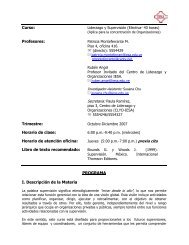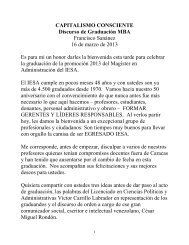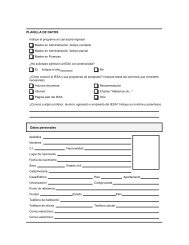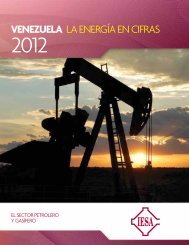VENEZUELA ENERGY IN FIGURES - Servicios IESA
VENEZUELA ENERGY IN FIGURES - Servicios IESA
VENEZUELA ENERGY IN FIGURES - Servicios IESA
- No tags were found...
You also want an ePaper? Increase the reach of your titles
YUMPU automatically turns print PDFs into web optimized ePapers that Google loves.
What impact will this reform have on the state’s<br />
share in the oil revenue and the operating companies’<br />
profits? How will the distribution of<br />
income between the budget and the FONDEN be<br />
affected? Taking the current estimated price in the<br />
budget (U.S. $ 55) and a cost index based on the price<br />
per barrel, we proceed to answer these questions..<br />
means least 1.7 billion dollars a year in contributions<br />
to the state (assuming each barrel exported sells for $<br />
100). The government hopes to offset the reduction<br />
in two ways: (1) with the recent devaluation of the<br />
bolívar will receive 46.5 percent more in bolivars for<br />
each barrel and (2) the increase in profits for manufacturers<br />
is expected to lead to increased production.<br />
Using prices of U.S. $ 100 per barrel, the new law implies<br />
a reduction of state involvement in the sector’s<br />
net income (government take) of 2.4 percentage<br />
points: 83.4 to 81 percent. At this price the contribution<br />
to the State becomes $ 62.28 per barrel, instead<br />
of 64.11 under the old law. Taking 2011 exports (the<br />
latest official figure available), reduced participation<br />
GOVERNMENT TAKE <strong>IN</strong> OIL REVENUE (PERCENTAGES)<br />
Effective Tax Rate (Net Income) = Percentage of net income that accrues to the State<br />
100<br />
2011 LAW<br />
PERCENTAGE<br />
90<br />
80<br />
2013 LAW<br />
Source: Authors’ calculations based on the<br />
Official Gazette of the Bolivarian Republic<br />
of Venezuela No. 40,114 dated February<br />
20, 2013<br />
70<br />
30 40 50 60 70 80 90 100 110 120 130 140 150 160 170 180<br />
PRICE US$/BBL<br />
The reduction of government take has its equivalent in increasing the utility of the producers. The utility,<br />
defined as net income over costs (including taxes), increased by two percentage points: 15 to 17 percent.<br />
Net income increased by $ 1.83 per barrel (from 12.78 to 14.61), again assuming a price of $ 100. With this<br />
increase in the operating companies’ profits, the government expects to alleviate the cash flow of Petróleos<br />
de Venezuela (PDVSA) and break the lethargy that characterizes current efforts to increase production.<br />
While certainly healthy for PDVSA and welcomed by the partner companies, the increase is unlikely<br />
to be considered satisfactory, if we take into account the country risk and political uncertainty. It is difficult<br />
to see a significant increase in production if this reform is not complemented with other changes in how oil<br />
policy is conducted.<br />
OPERAT<strong>IN</strong>G COMPANIES’ NET <strong>IN</strong>COME (PERCENTAGES)<br />
25<br />
20<br />
PERCENTAGE<br />
15<br />
10<br />
2011 LAW<br />
2013 LAW<br />
Source: Authors’ calculations based on the<br />
Official Gazette of the Bolivarian Republic<br />
of Venezuela No. 40,114 dated February<br />
20, 2013<br />
5<br />
12<br />
0<br />
30 40 50 60 70 80 90 100 110 120 130 140 150 160 170 180<br />
PRICE US$/BBL
















